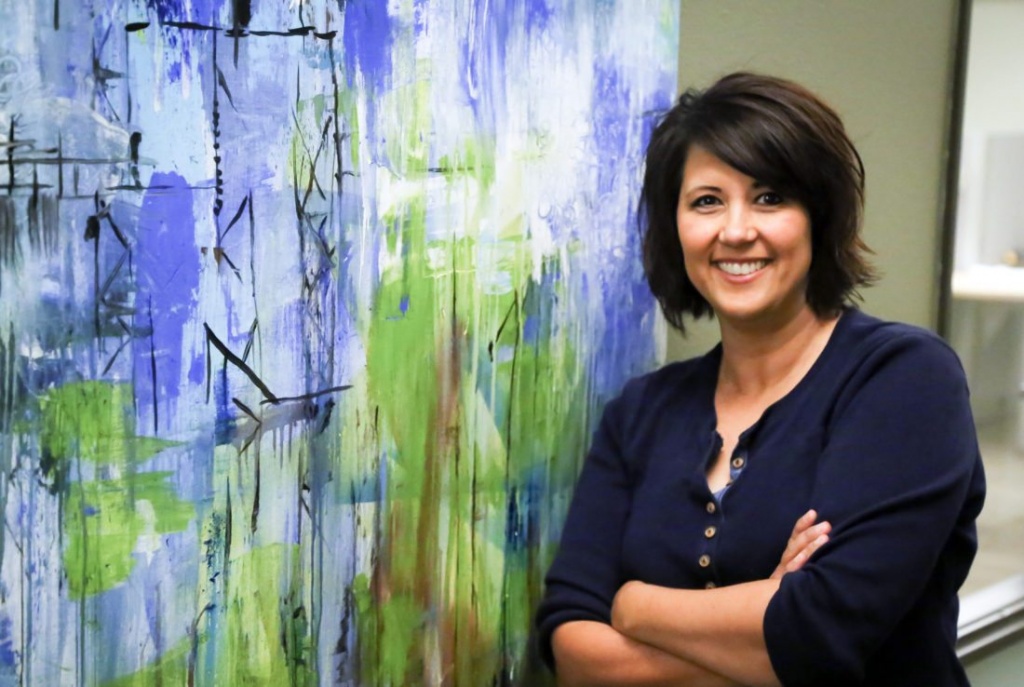
Candace Brekke
by Nicole Thom-Arens | Submitted Photos
Candace Brekke’s contemporary artwork has been on display in boutiques, cafes, and businesses in Minot for several years, but it took the artist years to find her peace on the canvas.
“In college, Walter Piehl was one of my professors, and I remember him saying I was too commercial—that I had to not only be more open and free with the medium, but with my mind—but I had just graduated from a technical program at Bismarck State College, where design and detail were ingrained in me. Realistic drawing was all I knew,” Candace recalls. “It wasn’t until after I graduated from Minot State University that I began relaxing a bit and really experimenting with paint and freedom of expression—it took me away from the computer.”
Candace’s career began as a website designer in the late 1990s while she studied commercial art at Bismarck State College. Despite always loving art, Candace didn’t initially know how to apply her passion toward a career.
“I was trying to decide what to do for a living when I hit college and couldn’t. I was thinking nursing. I was a CNA for a very, very, very brief period,” Candace remembers with a laugh. “Then my friend showed me graphic design. He went to BSC, and I was like, ‘Oh, yeah. Duh,’ art and making a living.”
As a child and while in college, Candace’s passion was realistic drawing.
“In elementary school, I liked to draw. I liked to try to draw realistic, so I’d just stay up at night and draw until my mom told me to go to bed, and then I’d still stay up later and draw,” Candace says.
That specialty in the realistic served her well in graphic design, but painting on canvas allowed her to get her hands dirty—something she really enjoyed.
“I finally found the freedom of the medium,” Candace says. “It didn’t have to be perfect. That drip, or that whatever, creates a cool texture or a cool pattern or what shows up underneath it once it’s dripping—it’s like it plays off of each other and I’m finally just able to let it go and just let it be what it wants to be.”
“I love the colors that she uses and the layering and the textures that you can see on the paintings,” Jessica Ackerman, a collector of EyeCandy, says. “If she doesn’t explain the meaning of it from her interpretation, I feel like I can come up with it on my own, and neither is really ever wrong. They bring meaning to a room.”
Last summer, Candace, who works as a designer for an engineering firm in Minot, returned to the details and intricacies she enjoyed as a child and teen when a group in town started The Kindness Rocks Project where community members decorated rocks to hide with the goal of bringing joy to people finding the special rocks.
“It was a good thing to do with the kids. It was a really good lesson, obviously. We’d go camping and sit and do rocks. We talked a lot about the lesson of the kindness project, so that was part of it,” Candace says. “The other part of it was that I found myself going back into detail again, which was funny—being able to take a rock, my paint pens, and my markers and go sit for a half-hour and just create. I’m never looking at anything for reference. I’m simply letting it come to me; it became therapeutic for me and still is.”
She describes her ability to see shapes and images in blank rocks or paint on a canvas as being similar to seeing shapes in the clouds. While there is certainly a debate among artists and consumers about what constitutes art, Candace believes the answer is in the eye of the beholder.
“Who’s to say what beauty is or how it got there?” she asks. “I’ve come to call myself a visual communicator instead of a graphic designer because that’s what it is. It’s visually telling a story no matter what medium you’re working with. That’s what I want to do. In advertising, you’re trying to convince. In photography, you’re trying to capture and tell a story through the emotions of that visual. Painting, you’re just trying to evoke some kind of emotion and speak to whomever you want to speak. It’s never just one thing for me and that’s okay. If someone finds beauty in my work, then that makes me happy.”
[supsystic-gallery id=142]Nicole Thom-Arens is a writer and an assistant professor of communication arts at Minot State University where she teaches journalism and communication theory courses and advises the student newspaper the Red & Green.
